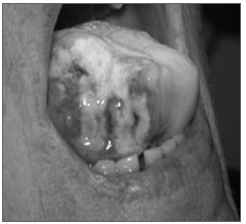

Year: 2007 Vol. 73 Ed. 5 - (20º)
Relato de Caso
Pages: 717 to 717
Tongue necrosis in a patient with cranial arteritis
Author(s): Gerson Schulz Maahs 1,Daniela Dias Fabricio 2
Keywords: cranial arteritis, horton's disease, temporal arteritis, tongue infarction, tongue necrosis.
![]()
INTRODUCTION
Cranial Arteritis (CA) is a giant cells vasculitis of unknown cause, which preferentially involves the extracranial branches of the carotid artery. It is the most common systemic vasculitis in adults 1.
Age is its major risk factor, and it affects patients above 50 years of age.
CA's classic manifestations are headache, mandibular claudication, rheumatic polymyalgia and visual symptoms1-3. Headache is the most common finding in about 70% of the patients affected. Rheumatic polymyalgia is usually seen as the systemic stage in CA, characterized by pain in the shoulders, neck and hips.
Visual symptoms such as vision loss and diplopia happen to one third of the patients. Blindness is the most feared complication. Systemic symptoms such as weight loss, fever and arthralgia are common.
In 40% of the patients there are atypical otorhinolaryngological symptoms such as dry cough, sore throat, dysphonia, neck pain and tongue involvement1,4. Tongue involvement is not uncommon, the main complaints are paresthesias, pain, glossitis and tongue claudication. Despite all of these, tongue necrosis and ischemia are rare events5.
Diagnosis is based on clinical history, physical exam and an increase in the erythrocyte sedimentation rate (ESR), which is usually higher than 100 mm/h1-5. In the patient's exam we can find anomalies in the temporal artery such as pulsation increase or interruption. Diagnosis is confirmed by temporal bone biopsy, which shows mononuclear infiltration or granulomatous inflammation.
CLINICAL CASE
A 68 year old Caucasian female, started having pain in her right temporal region and mandible. Later on, she presented with intense tongue pain, which in 30 hours evolved to tongue necrosis and ulceration in the right side latero-anterior region, with considerable loss of tongue tissue (Figure 1).
Figure 1. Tongue necrosis.
The right temporal artery was thickened. The ESR was of 113 mm/h. We started her on 60mg of prednisone and 100mg of azathioprine. Clinical response came after three months, and was very satisfactory, with regeneration of the tongue tissue.
DISCUSSION
Tongue necrosis is a rare occurrence in cranial arteritis. It happens through the stenosis and occlusion of the lingual and contralateral arteries. Tongue claudication and pain during swallowing are important warning signs in order to avoid its evolution towards tongue ischemia and necrosis. Once the ischemic process starts, it seems to progressively evolve towards tongue necrosis. In half of the patients, the necrosis is symmetrical in both sides of the tongue, in 20% the tongue dorsum is involved; and in 25% only the tongue tip is involved. In our case, the necrosis site was very uncommon, being assymetrical and involving the right side latero-anterior portion of the tongue.
Some authors have described the onset of ischemia related to the use of ergotamine5,6, and self medication with this drug is usual in order to treat headache - a common symptom. This would happen because of a vasospasm caused by the drug in question, contributing to the arterial occlusion.
Tongue biopsy is usually non-specific and is not indicated.
The treatment of choice for CA is high doses of steroids, which may be associated to other immunosuppressants such as azathyoprine and methotrexate.
FINAL REMARKS
Although reported in the literature, tongue necrosis is not common. The otorhinolaryngologist must be familiarized with this pathology and its atypical manifestations in order to properly prevent its occurrence and also be able to treat its complications.
REFERENCES
1. Hellmann D. Temporal arteritis: a cough, toothache and tongue infarction. JAMA 1992;287:2996-3000.
2. Goodman BW. Temporal arteritis. Am J Med 1979;67:839-52.
3. González-Gay MA, et al. Epidemiology of biopsy proven giant cell arteritis in northwestern Spain. Ann Rheum Dis 2001;60: 367-71.
4. Hellmann DB. Occult manifestations of giant cell arteritis. Med Rounds 1989;2:296-301.
5. Bodenson J, et al. Tongue necrosis in temporal arteritis provoked by ergotamine. Journal of Internal Medicine. 1992;232:541-4.
6. Ginzburg E et al. Lingual Infarction: a review of the literature. Ann Vasc Surg 1992;6:450-2.
1 PhD in Surgery, M.S. in Medicine. Otorhinolaryngology and Head and Neck Surgery Consultant. Professor at the Medical Residency.
2 Otorhinolaryngologist, colaborator at the Otorhinolaryngology - Head and Neck Surgery Department of the São Lucas Hospital - PUCRS.
Serviço de Otorrinolaringologia e Cirurgia de Cabeça e Pescoço do Hospital São Lucas da PUCRS, Porto Alegre RS.
Mailing Address: Gerson Maahs - Avenida Ipiranga 6690 Centro Clínico da PUCRS conjunto 511 Porto Alegre RS.
Paper submitted to the ABORL-CCF SGP (Management Publications System) on November 22th, 2005 and accepted for publication on July 26th, 2006. cod. 1598.
All rights reserved - 1933 /
2025
© - Associação Brasileira de Otorrinolaringologia e Cirurgia Cérvico Facial
